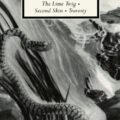Infinitely Weird Flights of Mind: Jeremy Bushnell’s The Insides

Our senses discern four dimensions, three spatial and one temporal. Quantum physics notably augmented this self-evidence with anywhere from six to an infinite number of unobservable dimensions. So where are these other dimensions and what’s going on in them? In his new novel, The Insides, Jeremy Bushnell explores the implications and metaphorical resonance of these questions.
Ollie Krueger is an haute cuisine butcher working at Carnage, a restaurant where meat is “deconstructed.” When we meet her, she’s carving a carcass across from her workplace rival, Guychardson. The latter repeatedly outslices her in their unspoken competition and Ollie cannot fathom her opponent’s prowess with what looks to be an inferior utensil. She begins to observe his technique and notes,
…there’s something off about the way he does it. It looks fake, like a movie. A movie where, for some reason, they needed to fake the act of butchery, rendering it in photo-realistic but unconvincing CGI. All the textures are right, but all the physics are wrong. Why would they do it that way, she thinks, losing herself in the idea. When they could just have gotten a real butcher?
A former dabbler in the occult arts, Ollie begins to wonder if there is something special (magic?) about this knife. After a period of perplexed frustration, she finally asks Guychardson if she can “see” it. Instead of handing it over, he brandishes it like a sword and fluorescent glints of light shoot off it, refracting the opened carcass beneath Ollie into “abstract patterns.”
The meat surges in her vision, threatening to take on the status of landscape.
Overwhelmed by the display, Ollie has a psychotropic seizure. Fits like these have overtaken her from time to time, we learn, and this one yields a glimpse into what will turn out to have been The Insides. Ollie is mentally transported to a farmhouse where she has abandoned her husband and son. It is surrounded by a decaying landscape. Crops are neglected, irrigation is in disrepair, and her son has been transformed into a sinister clown in greasepaint.
This uncanny scene sets the tone for a Murakami-meets-Dungeons-and-Dragons mystery. Ollie becomes obsessed with the magic knife and the seams it seems to have ripped open in the fabric of space-time, “Time as tissue.”
She wonders if there were a way back through time to rectify her mistakes and return to the family she has unaccountably abandoned. Her roommate, Victor, is a friend from her punk-witch days, and the two delve back into the dark arts hoping to resolve the mystery, careless of the “Possible Consequences.”
Meanwhile, the novel’s antagonist, Pig, has employed a psychic to find some mysterious object for him. A self-indulgent neo-Nazi who seems to live entirely off of sugar snacks, Pig is to The Insides what Chigurh is to Cormac McCarthy’s No Country for Old Men. This rough beast of the Alt Right will pursue a powerful talisman from Boston to the Bronx, guided by his reluctant bloodhound, Maja, a seer with trauma in her past and the miraculous ability to track anything, simply by palpating what’s come into contact with it. “If you look closely enough, every object can always be connected, somehow, to someone’s suffering.”
These plotlines converge when Maja locates the object in question, and that’s when the weird energy gives way to a Manichean conflict, replete with rampaging psycho, chase scenes, gratuitous sex, murder (blood sacrifices of secondary characters) and mayhem, under the duress of which characters deliver one-liners. Reminiscent of a William Gibson thought experiment turned action movie, even these spectacular scenes would be digestible as genre satire, if not for the author’s insistence on connecting all the dots.
By the end of the novel, the space oddities have been effectively explicated, as the socio-historical back story strongly suggests what’s been happening and why. We’re even told what might happen to the protagonist after we close the book on her.
No doubt, the preceding betrays the aging critic’s nostalgia for evocative loose ends. (The potential for spoiler is the spoiler.) Arguably, the substance of a great book ought to be unspoilable (via review), but in an age where no mystery is left unmolested and every fact is at one’s fingertips, perhaps today’s reader is conditioned to expect resolution or at least something approximating closure. What can be known ought to be, even if it’s an illusory (alternate) “knowledge.” Dave Eggers parodies this tendency to its logical conclusion in The Circle.
The realm of twenty-first-century literature is far too heterogeneous to identify a singular ethos—The Age of The Age of a critical relic—but perhaps literary givens and goals are undergoing a paradigm shift at present.
By the twentieth century, narrative resolution had come to be seen as a Dickensian parlor trick sure to degrade the author’s “status,” whereas “serious” authors tortured, bewildered, and often slew their protagonists with neither edification nor consolation. From Melville’s Bartelby to Beckett’s hapless tramps, “great” authors have rendered human being more or less pointless, indeterminate and/or irredeemable. Is this view closer to some eternal truth about existence or was it just another (morbid) authorial affectation?
Perhaps Alan Bennett’s Kafka—“I always expect to be disappointed. If I’m not disappointed, then I’m disappointed.”—is emblematic of the old guard being laughed off the stage. Contemporary readers have come to expect an explanation for everything from the origin of stars to what Balki wore in episode 4, season 3 of Perfect Strangers. Fictive indeterminacy thus straining the suspension of disbelief.
The Insides participates in, but also problematizes this Information Age positivism. Sights set on the infinitely weird flights of mind and matter, the novel nonetheless struggles to set a tone as it explores space-time’s niches, eddies and interstices. At turns campy, arch, theoretical, sentimental, cinematic, socio-cultural, poetic, fey, fabulist, etc., the reader is tossed in a tonal whirlwind among genres and registers. This chaotic thrust hits and misses all through the narrative, but the heady magic broached in the initial knife-wielding scene (at which point the atmosphere was electric) is eventually played out and undermined by its sleuthing, explanatory endgames.
It is the kind of novel that creates its own parameters, its own world and must remain formally true to itself, not to the dictates of composition or genre, but, as Wallace Stevens asserts, “The imagination loses vitality as it ceases to adhere to what is real.” Therein the threshold too many speculative fiction, fantasy, and sci-fi writers pass en route to frivolous escapism and/or reader requital.
Though it is, at intervals, rooted in socio-cultural psychology and the emotional lives of its characters, The Insides continually escapes its own gravity, launching into occult elaboration and movie mayhem. Its hyper-dimensional framing device (so prevalent in contemporary fiction it’s become a sub-genre) takes a provocatively literal, visceral view of an oft-idealized physical reality (insofar as quantum physics describes one). The conceit of superficial/intestinal cultivates critical densities, which the authorial hand plunges into up to the elbow. This promising brand of gutty surrealism never quite fleshes out the corpus, however, its flights of fancy passing in and out of its own consciousness as the wispy back stories dissipate rather than coalesce.
Bushnell’s evisceration of space is a wildly imaginative and compelling penetration of the surface (spatial, personal). Opening wounds in flesh and space-time alike, the author plumbs the interior lives of his characters like an oracle butchering some sacrificial beast to read its entrails. Whether the reader’s condition improves or disimproves (sic) by the subsequent suturing of those wounds, will be a matter of constitution.
About Steven Felicelli
Steven Felicelli is the author of two novels, six plays, three volumes of poetry, and various other publications (from book and film reviews to the co-translation of a Japanese folk song for The United Nations). He has received fellowships from The Edward Albee Foundation, Bread Loaf, and The Millay Colony.




